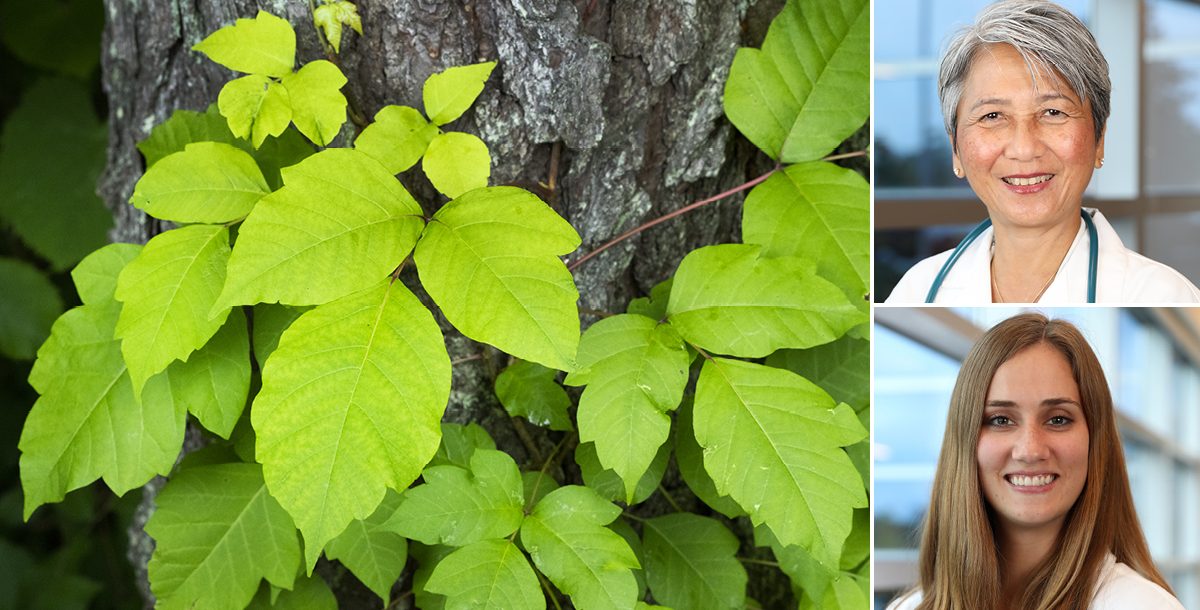During the summer months, things are in bloom, including poisonous plants. Therefore, it’s important to know the differences between poison ivy, poison oak and poison sumac so you keep you and your loved ones safe from their effects.
All three of these poisonous plants come from the same family of weeds and cause similar skin reactions.
However, there are ways to distinguish between the three plants based on geographical location and appearance:
- Poison ivy is a three-leafed green weed with a red stem at the center (pictured above, left). Its leaves can be shiny or smooth. It grows like a vine and can be found in all parts of the United States except for the Southwest. Typically, its leaves turn red in the fall.
- Poison oak also has three leaves, but it grows as a shrub and not a vine. It can have a textured, hairy surface and is less common than poison ivy and poison sumac.
- Poison sumac is primarily seen on the West Coast. Poison sumac often forms seven to 13 leaflets arranged in pairs along a central stem and is a shrub, not a vine. It is also found in the swampy areas of the Mississippi River region.
“Once you are familiar how they look, it will be easy to tell them apart,” Eleia Reyes, MD, (pictured above, top right) a primary care doctor at Mercy Health – Tri-County Primary Care, shares.
But if in doubt, “the rule of thumb is ‘leaves of three, let them be,’” Rachael Doll, (pictured above, bottom right) a primary care nurse practitioner at Mercy Health – Sayler Park School Health Center, adds.
Both Dr. Reyes and Rachael encourage adults and children to avoid and eradicate these poisonous plants, if possible.
“All three plants have the same oil, urushiol, which is what causes the uncomfortable skin reaction, known as dermatitis, that’s associated with these plants,” Rachael explains.
“Symptoms include an itchy, blistering rash,” Dr. Reyes adds.
And Rachael continues, “those who get dermatitis from any of the three ivies cannot transmit it to others from their lesions. You can only get the rash from direct exposure to the plant oil. And while wearing protective clothing is helpful, be mindful that the oil from the plants can stay on clothing, under nails and on pets for days at a time. It is important to change your clothes immediately after you come indoors if you suspect you have encountered any of the three ivies.”
If you know that you’ve been exposed to one of these plants, Dr. Reyes recommends the following.
First, wipe down the surface of your skin with an alcohol wipe. Immediately following that, clean your entire body with warm, soapy water.
Also, remember that every person reacts differently to the three ivies based on how much exposure they have had and how sensitive they are to the oil.
“If they are allergic to the oil, their reaction can range from mild to severe,” Dr. Reyes shares. “It can be very uncomfortable due to itching and blistering. It is not dangerous per se, unless it gets infected. You may need to seek medical care if the rash is widespread or if it includes the face and/or genitals.”
Rachael adds, “some kids and adults can have very mild reactions and over-the-counter remedies will work to give them relief from their symptoms. Others will need to see their pediatrician or family provider to get prescription-strength oral and topical steroids. It is very rare to need hospitalization from contact dermatitis, but this is more likely to happen if the poison ivy, oak or sumac contacts someone’s face.”
Soothing measures such as oatmeal baths, calamine lotion and cool, wet compresses are beneficial to help with the pain and itching associated with exposure to the irritating oil of the plants. You can also gently rub ice cubes on the affected spots multiple times a day. Cortisone, an over-the-counter steroid cream, can also help with reducing itch and the lesions.
Antihistamines such as Benadryl or Zyrtec also help treat the itching symptoms of exposure. These are best used at night to help prevent itching and scratching during sleep for those who experience increased itching at night.
“Make sure to see your provider if you develop a severe eruption that is unresponsive to previous treatments, if there is any evidence of infection, any new eruptions or rashes, severe poison ivy on the face, or fever,” Rachael advises. “It is also important to keep fingernails short and clean to prevent further damage to the skin from itching.”
When it comes to using activated charcoal to treat the symptoms of poison ivy, oak or sumac, there is little to no medical literature to support it as an effective treatment. Be sure to first check with your primary care provider first before using activated charcoal as a treatment for dermatitis.
Some regions are experiencing increased sightings of poison hemlock this year.
This plant has white flowers with an umbrella shaped head and green, fern-like leaves. The flowers eventually turn into a green, deeply ridged fruit. It grows from four to 10 feet tall, the leaves and stem are not hairy, and the stem has small purple spots. All parts of the hemlock plant are poisonous, even the roots.
“Poisonous hemlock is toxic to animals and extremely poisonous to humans if ingested or inhaled,” Dr. Reyes says. “It causes alkaloid poisoning, which can lead to respiratory paralysis, confusion, convulsion, rhabdomyolysis, kidney failure, coma and even death.”
Rachael adds, “if you have been exposed, contact poison control for more instructions. Signs and symptoms related to poisoning are dilation of pupils, trembling, dizziness and slow heartbeat. If you know someone who ingested it, go to your nearest medical facility to receive care.”
Do not burn the hemlock plant, as this releases the toxins into the air that can make you sick if you inhale them. Also, do not put poison hemlock in a compost pile either, as the toxins decompose slowly and take several years to dissipate. Instead, if you see poison hemlock, call a local agency to help remove the plant.
Learn more about the primary care services we offer at Mercy Health.






